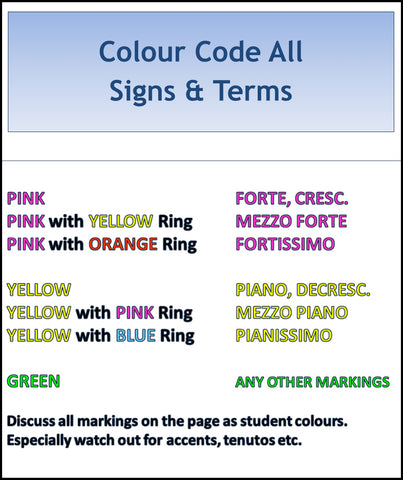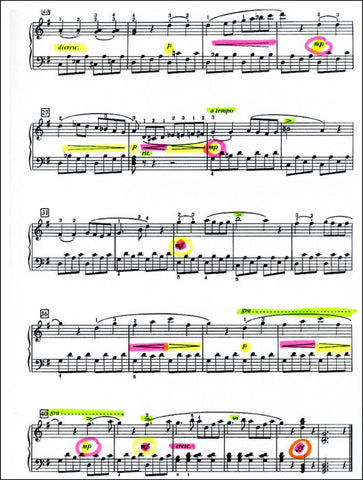The Colours of Music Darlene Irwin
”Music is written in black and white…..all you have to do is add the colours!” 
There are many different ways to describe colour in music—dynamics, volume, expression, louds and softs, subtle shades of light and dark.
Colour adds interest and beauty to music. Without it, music would be boring. It’s how the composer and the performer convey the message, meaning and emotion of the music to the listener. It's such an important part of a performance.....I call it the icing on the cake. Unfortunately for our students, it also tends to be the first thing that disappears when they are under pressure. Nerves have a way of erasing the colours! So how do you teach your students to remember the colours when they are performing?
Many years ago, I heard an adjudicator at a festival class describe music as a black and white colouring book. She told the students that it is up to them to add the colours for their audience.
At that point, I had a brainwave....I love it when that happens!!! In order for students to remember the colours they need to SEE them! And so I came up with a colour code for music. My theory was that if they saw the same colours over and over again, they would be more likely to play the dynamics correctly. Their brain would eventually begin to associate specific colours with the corresponding dynamic markings. I used highlighters so that the colours would jump off the page!
Here are the colours that I use with my students with the pedagogical reasons behind them:
- PINK for forte (loud) and crescendo (getting louder). It is a very bright colour and it indicates a loud sound.
- YELLOW for piano (soft) and decrescendo (getting softer). It is a much softer, less intense colour for a quiet sound.
- PINK with a YELLOW ring around it for mezzo forte (medium loud) because it is softer than forte.
- YELLOW with a PINK ring for mezzo piano (medium soft) because it is louder than piano.
- PINK with an ORANGE ring around it is for fortissimo (very loud). Orange is a very bright colour and so it reminds them to play louder than forte.
- YELLOW with a BLUE ring around it for pianissimo (very soft) because blue is much softer colour. The BLUE colour tells them to play softer than piano.
- GREEN is used for all the other markings on the page - accents, tenutos, any Italian terms, repeat dots, octave higher or lower, etc. Green can also be used for pedal markings if needed. I often tell my students that a sneaky little tenuto can hide on the page until it is coloured!
- PURPLE is not included in the chart below because I rarely use it. It can be used occasionally for showing stem directions, especially if the piece is written in one clef but played with both hands. It can also be used to colour slurs or staccatos, if students are having trouble remember them. However, I don’t usually colour all slurs or staccatos because it gets too confusing. There is just too much colour on the page. PURPLE can also be used to colour one of the voices of a Fugue.

When introducing a new song to a student, the first thing we do is colour the piece. As the student colours, we talk about everything on the page. That way, I know that they understand all the markings before we begin learning the piece. When the dynamics are coloured, students are also able to spot patterns in the music (sequences, echoes, terraced dynamics etc). This helps when they are memorizing their piece.....they can visualize the colours as they play.
Here is an example of a simple piece that has been coloured. This is a Grade 2 piece called Gavotta in G+ by James Hook. Can you find the dynamic echoes?

Here's a more complicated piece - Sonatina in G+ by Diabelli (Page 1 and Page 2). Having the accents or tenutos coloured green is helpful because they are quite often the destination notes in the phrase. This can then lead to a discussion about melodic shaping.


Colouring can be used effectively with senior students as well. Here is an example of how I would colour the Fugue in E+ (J.S. Bach). Notice how each voice has been coloured differently so that the student knows exactly where the lines are. I have also used arrows to show where the voice entries are. (NOTE—Arrows will be discussed in a future blog post).

I have coloured music with my students for many years and I have used this technique with students of all levels. It has been a wonderful tool for helping them to perform their best. Over the years, my students have done many exams, recitals, evaluations, festival classes and auditions. It's important to note that adjudicators and examiners have never had a problem with or even mentioned the fact that my students were using music that was coloured.
Colouring a piece is such a fun activity to do at the lesson. My students have often told me that a piece doesn’t look ‘worked on’ if it’s not coloured! Have fun colouring with your students!!
♥︎ Remember.....Great Music Comes From the Heart ♥︎

Photo credit: Rocky Mountain Sunrise (Canmore, AB) by Peter Eggers

